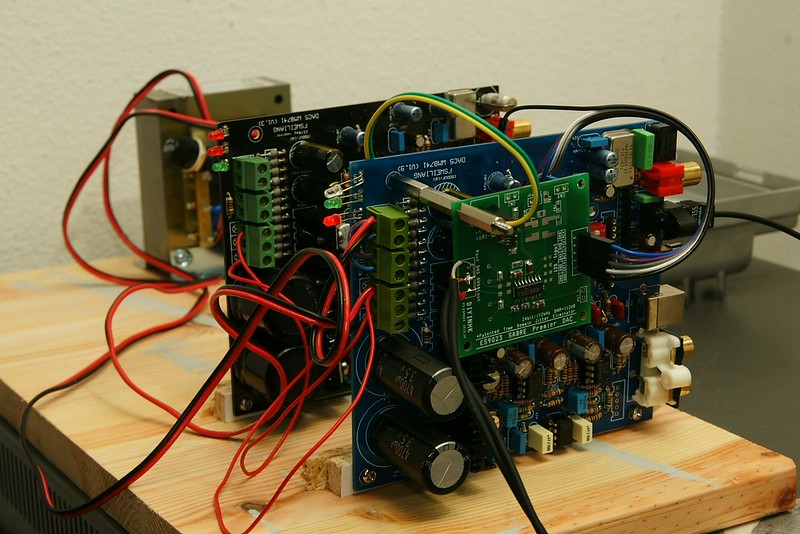Over the last few months, I’ve played with many recent D/A converter chips and shown that some of them show quite significant but hidden distortion. The only brand I hadn’t captured yet was one of the world’s most famous – Burr Brown (now part of TI). Continue reading
Author Archives: remco
Cirrus Logic CS4385
Another post, another D/A converter. Yes, this is one of my soap boxes and hopefully I’ll be able to post something else soon. Sorry folks, we have to get through this… 🙂 Continue reading
Analog Devices ADAU1966
Another D/A converter chip had the pleasure of spending some time with the Audio Precision. This time it was the ADAU1966, on the official evaluation board from Analog Devices. Continue reading
AKM AK4393
The following measurements were taken with an M-audio Delta 1010 sound card, using channels 7 and 8. These cards have an AKM AK4393 D/A converter. The M-audio has an otherwise fault-free design and is a great converter for the price.
Input was S/PDIF, output balanced -4 dBV.
I’m dropping the raw measurements here with little comments as long as the results are in line with what you’d expect from a device like this, since I’m mostly interested in the IMD measurements, after the last post… Continue reading
WM8741 vs. ESS9023
I’ve been looking at designing a D/A converter for a while now. In my experience these are some of the hardest audio components to do right. It started with building output stages over a decade ago and at some point I even found myself in a company designing a D/A converter transistor by transistor.
However, as recent experiments have shown, I still have a lot to learn.
ESStech gets it. Well, almost.
Recently the ESS Technologies products caught my attention (keep an eye out for some measurements shortly).
Just today I stumbled upon a presentation called ‘Digital vs. Analog Volume Controls‘ which is interesting in light of my opinion written some months ago, ‘The Case for Digital Volume Control‘.
Although probably written with a strong marketing purpose, a number of observations make me think there are some gaps in mixed-signal architecture thinking that deserve attention. Continue reading
Audio Precision System Two
As I mentioned in the ultranalyzer post I have been searching for ages for an AP System One, but hesitant to shell out big money for such an old, unsupported machine.
So what was I to do when a System Two came along…?
The BMWFord
Again, not an audio post!
But this is a project that has been going for almost a year and a half, and needed to be finished before I can dedicate myself to the big audio project I want to undertake.
Years ago I was at the pediatrician (aka children’s doctor) where they had built a car cockpit complete with steering wheel and gauges. The kids loved it, and frankly so did I. But- nothing worked for real of course. I thought I could do better, so I scoured eBay and scored a BMW E36 dashboard, a playstation2 gas / brake pedal and a steering wheel from a 1987 Ford Scorpio.
The Case for Digital Volume Control
Many audio systems are at least partly analogue, i.e. there are analogue sources and there is an analogue pre- or power amplifier. However, it is becoming more and more often the case that there are no analogue sources at all, or that due to the presence of a DSP in the system, all analogue inputs are converted to digital.
In the case where your audio system is primarily digital, many people still swear by analogue volume control. And I don’t really get it – I have never understood the reasons quoted for doing so, and the added complexity (not to mention more components in the signal path!) is just cumbersome. Even colleagues whom I regard to be absolute geniuses and designed some of the world’s best D/A converter chips could not convince me why this would be a good solution.
So, I’m going to put a stake in the ground here and open the floor to what I expect will be a massive flame war. Bring it on… Continue reading
Ultranalyzer reference measurements
When you are using consumer-grade sound equipment to measure consumer-grade sound equipment you are potentially setting yourself up for a major pitfall: how do you know you will be able to see the DUT‘s performance and not that of your measurement gear? The first way to make sure is of course to use measurement gear of very high performance, outclassing most of the stuff that will be measured with it, leading to the choice of the delta 1010. But that’s only step 1. Therefore I decided to make some measurements to see what the 1010 is capable of. We should be able to get close to specifications of the D/A (and/or) A/D converter used, but how close and what that looks like remains to be seen! Continue reading

